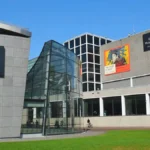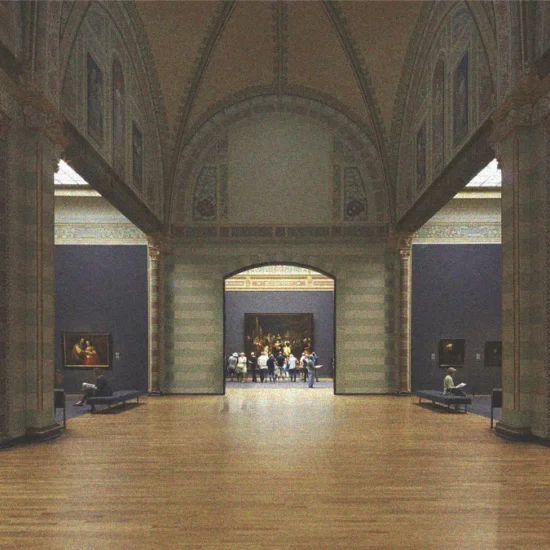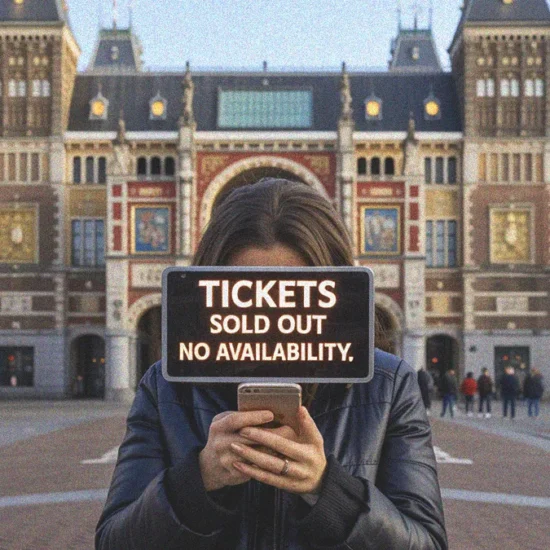Table Of Content
- Key Takeaways
- The Must-See Masterpieces That Make the Rijksmuseum Worth It
- Don’t Miss These Hidden Gems & Unique Treasures
- Look Around, The Building Itself Is a Work of Art
- Booking Rijksmuseum Tickets: The Smart Way to See It All
- See It All Without Getting Confused
- FAQs: Frequently Asked Questions
- Conclusion
I remember my first trip trying to find the best things to see in the Rijksmuseum. I walked in excited but left feeling overwhelmed. So many paintings. So many rooms. I didn’t know where to start. I spent hours wandering, missing the real gems everyone talks about. It was frustrating — like being lost in an art maze without a map.
I wanted to feel inspired, not confused. If you’ve ever stood in front of a masterpiece and wondered if you were missing something bigger, you’re not alone. That’s why I put this guide together — to help you skip the chaos and see what truly matters inside the Rijksmuseum.
Key Takeaways
- Rembrandt’s “The Night Watch” and Vermeer’s “The Milkmaid” are the museum’s top masterpieces; don’t miss them.
- Book timed-entry tickets online to avoid long queues. ToursTravelFinder has great options.
- Go for a guided tour if you want the fascinating stories behind the art; reserve your spot here.
- Don’t overlook unexpectedly magical Dollhouses, naval models, and stunning building interiors.
- Combine your visit with the Van Gogh Museum or a canal cruise for a full, art-filled Amsterdam day.
The Must-See Masterpieces That Make the Rijksmuseum Worth It
The Rijksmuseum is a living archive of Dutch history, creativity, and emotion. With over 8,000 objects on display, it isn’t easy to know where to begin. These masterpieces represent Dutch Golden Age paintings and tell timeless human stories.
If you’re short on time or just want to be sure you’ve seen the very best the museum has to offer, these are the top masterpieces in the Rijksmuseum you shouldn’t miss:
1. Rembrandt’s The Night Watch (1642)

This is one of the most important works in European art history. Rembrandt van Rijn broke every rule with The Night Watch, painting a dynamic portrait of Amsterdam’s civic guards that pulses with life and motion.
What makes it so revolutionary is Rembrandt’s masterful use of chiaroscuro (light and dark contrast), bringing characters forward with a theatrical glow. I kept staring at this one along with a lot of tourists; hopefully, you will feel it too.
Location: Still on display in the Gallery of Honour, though currently undergoing Operation Night Watch, a live restoration project. You can see the conservators at work through a glass enclosure.
2. Vermeer’s The Milkmaid (c. 1658)

Johannes Vermeer’s The Milkmaid is perhaps his most iconic work after Girl with a Pearl Earring (which lives at the Mauritshuis in The Hague).
This small but powerful piece captures a kitchen maid pouring milk. It’s simple, right? But the rich texture of the bread, the glow of natural light, and the almost meditative focus of the subject elevate the mundane into something quietly spiritual. It’s a celebration of domestic life and the dignity of daily routines.
Location: In the Gallery of Honour, near Vermeer’s other works, you will also find experiences.
3. Frans Hals’ Portrait of a Couple (c. 1622)

Frans Hals brought movement and personality to portraiture like no one else. His lively brushwork and expressive faces made his subjects feel alive. In Portrait of a Couple, he captures a newlywed pair in a garden, holding hands. There’s joy, warmth, and a beautiful sense of intimacy that make this work stand out among more formal portraits.
Location: Gallery of Honour, near other Dutch portrait masters.
4. Jan Steen’s The Merry Family (1668)
Jan Steen was the king of domestic comedy. His scenes are chaotic, colorful, and packed with meaning. The Merry Family is one of his best-known works. Here you’ll witness a family drinking, singing, and generally ignoring all sense of responsibility. Also, it concludes with a child smoking a pipe and a toddler pouring wine. Just playful chaos.
Location: Also in the Gallery of Honour, among Steen’s other genre scenes
5. The Syndics of the Drapers’ Guild by Rembrandt (1662)
Often overshadowed by The Night Watch, this later Rembrandt work is arguably even more masterful in its restraint. The Syndics shows five cloth inspectors at a table, caught mid-meeting, glancing toward the viewer with a look of quiet judgment and curiosity.
It’s one of the best examples of group portraiture in the Dutch Golden Age, which is subtle, powerful, and full of life.
Location: Gallery of Honour, just opposite The Night Watch.
6. The Threatened Swan by Jan Asselijn (c. 1650)
This one often surprises visitors. A dramatic, almost cinematic image of a swan defending its nest, this painting became a national symbol of Dutch resistance.
It wasn’t originally intended as political. It was only later reinterpreted that way. But the energy, emotion, and sense of protection in this swan’s stance are unforgettable. It’s not just about birds. It’s about standing your ground.
Location: First floor, in the Hall of Fame.
7. Woman Reading a Letter
Painted around 1663, Vermeer’s Woman Reading a Letter captures a private moment of quiet tension and drama. Though the letter is hidden, her expression speaks, perhaps of longing, surprise, or both. Subtle details like the map on the wall and her rounded belly
hint at a love letter and an unexpected pregnancy. With only 34 known works, each Vermeer painting offers a rare, intimate glimpse into human emotion.
Tip to Know: All of the major masterpieces, including works by Rembrandt, Vermeer, Hals, and Steen, are located in the Gallery of Honour (Eregalerij) on the second floor. Book your Rijksmuseum tickets ahead to witness the most interesting paintings.
Don’t Miss These Hidden Gems & Unique Treasures
Some of the Rijksmuseum’s most magical moments are found just off the beaten path. These hidden gems might not always make the top 10 lists; however, they often leave the deepest impressions, especially for those who love stories, quiet corners, and little windows into everyday life of centuries past.
Here’s what to keep an eye out for when you need a pause from the crowds and a deeper breath of wonder.
1. The Cuypers Library

It’s a place where art meets with silence. Step softly into the oldest and largest art history library in the Netherlands, and you’ll understand why it’s called a hidden treasure. The Cuypers Library, named after museum architect Pierre Cuypers, is a breathtaking space. You’ll find four levels of bookshelves, iron railings, and spiral staircases.
It’s not just for researchers. Even casual visitors like us can see from behind a glass wall. If you’re someone who finds peace in old pages and the scent of history, this is your spot.
Location: East side of the museum’s first floor, near the 19th-century art collection.
Want to explore more stories like this with context? Try the Rijksmuseum reserved access ticket to skip the crowds and spend your time wandering at your own pace.
2. The 17th-Century Dolls’ Houses
Forget everything you know about dollhouses. These are symbols of wealth, style, and domestic life from the Dutch Golden Age. Built by wealthy women (including Petronella Oortman, whose house is the most famous), these miniature homes were handcrafted with real silver tea sets, Persian carpets, Delftware, and tiny oil paintings.
Every room tells a story of that time. How people lived, what they valued, and their world. It’s social history, after you put your eyes on it? you might not want to look away.
Location: First floor, in the Special Collections wing.
If you’re short on time and want to be sure you don’t miss this and other icons, consider the skip-the-line ticket with a tour.
3. Ship Models, Weapons & Armor
Sea voyages, battles, and exploration. This part of the museum is pure joy. The Special Collections section houses a rich display of detailed ship models, ceremonial weapons, naval cannons, and armor from different centuries. It’s immersive and shows how powerful the Dutch were at sea. Don’t miss the 18th-century ship model of the William Rex.
Location: Special Collections area, ground floor.
4. The Asian Pavilion
Inside, you’ll find art and artifacts from China, Japan, India, Indonesia, and other parts of Asia, Buddhist sculptures, lacquerware, and calligraphy. Plus, you’ll watch some delicate carvings of devotion, ritual, and artistic mastery. It’s not as crowded as the galleries, making it a peaceful moment in this busy museum.
Location: At the far end of the museum’s south wing, accessible via the underground passage.
Look Around, The Building Itself Is a Work of Art
Before you even reach the art, the Rijksmuseum makes an impression. It doesn’t just display beauty; it is beauty. Designed by Pierre Cuypers (yes, the same architect behind Amsterdam Centraal Station), the building combines Gothic drama with Renaissance elegance. So, it feels more like a palace than a museum.
- Vaulted Ceilings & Stained Glass: Step into the Gallery of Honour and you’ll find yourself surrounded by vaulted ceilings painted with stars, myth, and history. And stained glass windows. Some featuring artists, others showing virtues like wisdom and creativity. The light shifts the mood from room to room.
- Symbolism in Every Corner: Look closely and you’ll start to see it. Owls, lions, paintbrushes, chisels, and all the symbols etched into walls, archways, and even floor tiles. These are more than house art… if you pay attention.
- Step Inside a Story: The museum’s layout, its arches, and even the echo of footsteps…all of it creates a sense of movement through time. You’re visiting a museum and walking through the Netherlands’ artistic soul.
After all, from the paintings to the corners of the building, it is worthy of admiration. However, if you’re short on time, you can fast-track with a reserved ticket and focus on the parts that matter most to you.
Booking Rijksmuseum Tickets: The Smart Way to See It All
You arrive at the Rijksmuseum on a crisp Amsterdam morning, coffee in hand, ready to soak in centuries of Dutch history… only to find out it’s sold out for the day. It should not be that way, right?
That’s why booking your tickets in advance is essential, I would highly recommend.
No Walk-Ins Allowed
There’s no ticket booth at the entrance. None. Zero. All tickets must be reserved online. That means if you’re going to show up and chance it, you’ll probably end up wandering the Museumplein. So, book your tickets from the official site of Rijksmuseum or a trustworthy reseller like ToursTravelFinder, GetYourGuide, etc.
Standard Rijksmuseum Entry:
You can book tickets from the official sites. However, they open slots for a very limited time; due to high demand, it’s a tough deal to book tickets from the official site.
- Price: €22.50 for adults
- Free Entry: Children and teens under 18 go free!
- Discounts: EYCA and CJP cardholders score special rates
- Cancellation Policy: Only free tickets are cancellable. Paid ones? Nonrefundable.
Want to keep things simple? Grab your Amsterdam Rijksmuseum Reserved Access Ticket and secure your spot. Easy, fast, and confirmed.
Explore Deeper with a Guided Tour
Love history, stories, or just want someone else to guide you through the gems? A guided tour gives the artwork context and makes the visit feel like a living storybook.
My go-to top-rated options include
| Experience | Booking Link |
| Skip-the-Line Entry to Rijksmuseum | Book here |
| Amsterdam Rijksmuseum Guided Tour with Access | Book here |
Combo Tickets
Are you in Amsterdam only for a short time? Make the most of your visit to Amsterdam by combining the best activities with must-see attractions.
Combo tickets save you time and offer excellent value. Explore the Golden Age inside the Rijksmuseum and step into Van Gogh’s colorful world all in one go.
| Combo Option | Booking Link |
| Rijksmuseum + Canal Cruise Combo | Book here |
| Rijksmuseum + Van Gogh Museum Combo | Book here |
Want a smooth, all-in-one experience? These combos are perfect for first-timers or anyone on a tight schedule. Traveling with family? Children under the age of 18 can go free. It’s a huge money saver!
What If Tickets Are Sold Out?
Rijksmuseum tickets can disappear fast, especially during holidays or high season. But you’re not out of luck. Head over to ToursTravelFinder for last-minute tickets and guided experiences. These resellers often have access to time slots even when the official website says “sold out.”
Tip To Know: This is one of the best places in Europe. So visits in early mornings and late afternoons are the best times for availability and fewer crowds.
See It All Without Getting Confused
A little planning makes all the difference, and you don’t need to see everything to have a meaningful experience. Save this post to remember the highlights and follow this checklist:
| Get a Travel Adapter | Get Travel Insurance |
| Buy Your Flight Ticket | Purchase your SIM card in advance |
| Plan for comfortable footwear | Buy Convenient Luggage |
| Pack a Winter Jacket | Carry Documents Wallet and bring ID ( if required) |
| Arrive early (9 am to 10 am), and if you’re not a morning person, come after 3:00 PM | Book your ticket with a timed slot in advance |
| Booking.com | Skip-the-Line Entry to Rijksmuseum (Book Now) |
| Airbnb | Rijksmuseum + Canal Cruise Combo (Book Now) |
| HostelWorld | Guided Tour of the Rijksmuseum (Book Now) |
Tips: The museum opens at 9:00 AM daily, and that first hour is the quietest. If you plan to visit the gardens, check the weather forecast. Arrive 10–15 minutes early (lines can form at peak times).
FAQs: Frequently Asked Questions
Is photography allowed inside the Rijksmuseum?
Yes, photography is allowed, but only for personal use and without flash or tripods.
Be respectful around crowds and other visitors; some galleries get quite busy.
What are the top 3 things to see in the Rijksmuseum?
All the artworks are mystically beautiful. Among them, the top three must-see highlights are Rembrandt’s “The Night Watch,” Vermeer’s “The Milkmaid,” which is a timeless depiction of domestic life, and the Cuypers Library.
What are the official Rijksmuseum opening hours?
Based on visitor data, the museum is least crowded in Early mornings (9:00 AM–10:30 AM). Otherwise, Late afternoons (after 3:30 PM). Try on Weekdays, especially Tuesday and Wednesday, which are less crowded than the weekend.
When is the best time to visit the Rijksmuseum to avoid crowds?
The best times to visit the museum are before 11:00 AM and after 3:30 PM, especially on Tuesdays and Wednesdays. If you’re looking for peaceful gallery strolls and easier photo ops, these windows are golden.
Conclusion
Whether it’s your first time or your fifth visit to the Rijksmuseum, there’s always something fresh to discover, something that will catch your eye, as there are so many of the best things to see in the Rijksmuseum that move your heart.
So please don’t feel pressured to see it all at once. Take your time. Follow the rooms, the artworks, and the stories that speak to you. Let the museum guide you gently, not rush you. Book your tickets to experience a journey that you’ll want to return to again and again.








No Comment! Be the first one.